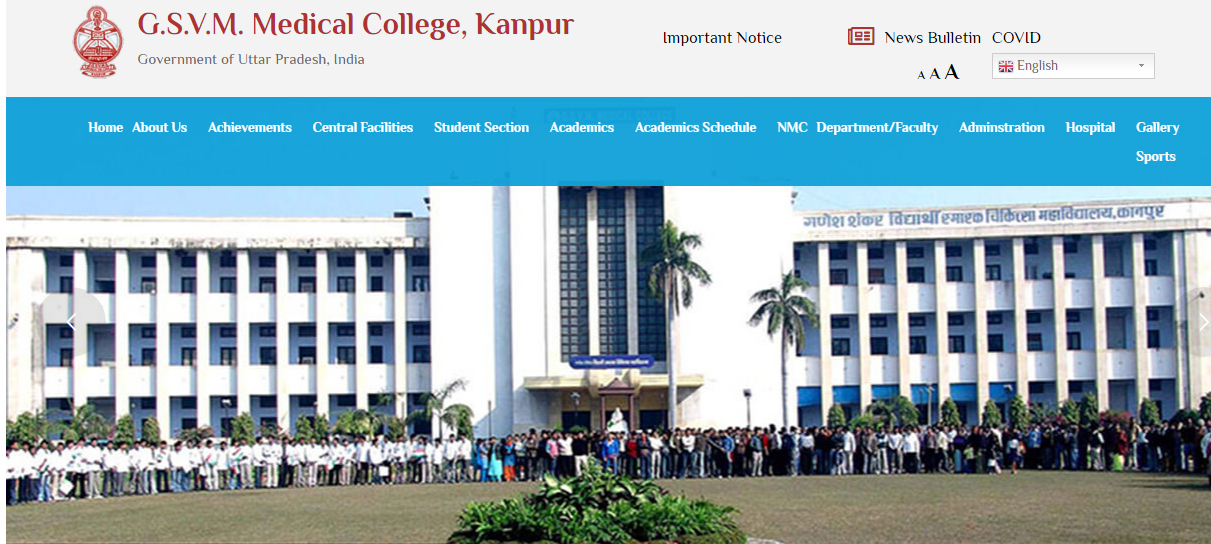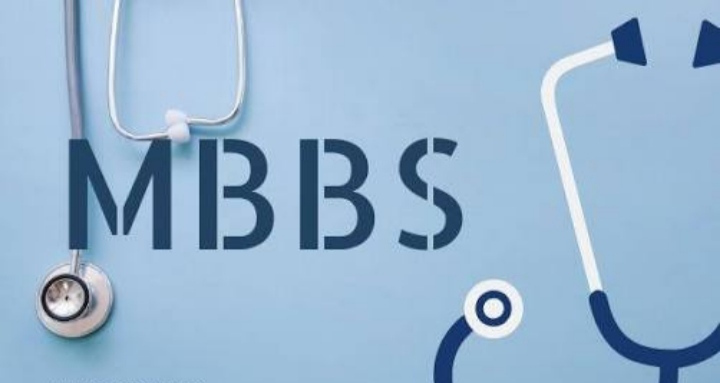
GSVM Medical College, Kanpur
G.S.V.M. Medical College is situated in the heart of the historic and industrial city of kanpur. The city of Kanpur is embraced by our most holy river ‘Ganga’ from two sides, northwest (Kalyanpur) and northeast (Jajmau). In the British period our city was known as Cawnpore. It has a special place in Hindu mythology. It’s Bithoor area is famous from Ramayana era. Presently the Kanpur city is famous for its industrial organization and educational institutes. Our city is the economic capital of Uttar Pradesh.
This Medical college has a sprawling campus with hospital and college sections accommodated in huge buildings. The main college building looks like a huge palace and is the biggest amongst all medical colleges in U.P. The main hospital (L.L.R Hospital) along with its sister units e.g. , Chest hospital, Infectious disease hospital, Children hospital, Maternity hospital, Cancer institute and Cardiology institute, constitute the biggest patient care center in Asia.
G.S.V.M. Medical College Kanpur, known for its academic excellence world over, is named after Late Shri Ganesh Shankar Vidyarthi, a great freedom fighter ,who lost his life at the altar of the communal frenzy in Kanpur in March 1931.
This was the first medical college of U. P. established in independent India, forming a landmark in the annals of medical education in the state of U. P. It is one of the five medical colleges in India established under the second five year plan.
This college came into existence in November 1955 and its foundation stone was laid down by Hon’ble Dr. Rajendra Prasad, the first President of India, on April 24, 1956. Late Dr. S. N. Mathur was the first Principal of this college. Teaching and training of the students was first started at King George’s Medical College, Lucknow due to pending construction of the building at Kanpur. Staff on temporary basis was recruited from 1st May, 1957 by selection through an ad hoc committee appointed by the government. The students had their training in pre-clinical subjects for the first two years at Lucknow and then the selected staff and all the students were shifted to Kanpur. Dr. C. B. Singh was mainly responsible for starting the teaching at medical college, Kanpur from 1st August 1957. This institution was inaugurated by Dr. Sampoorna Nand, Chief Minister of U. P on Dec. 13, 1959.
To begin with, the college was affiliated to Lucknow University and latter in 1968, when Kanpur University was established, the college was affiliated to it. Since then this medical college has been growing in every sphere and has earned a National and International fame for its excellent research work and teaching.
Diploma in Anaesthesia
GSVM Medical College, Kanpur
Diploma in Clinical Pathology
Diploma in Ophthalmology
PG Diploma in Ophthalmology – DO is a PG Diploma course offered.
The Postgraduate Diploma in Ophthalmology builds on medical and surgical concepts learned in anatomy, physiology and ophthalmic diseases during the graduate degrees. Ophthalmology proposes to avert blindness, ascertain ocular health and rehabilitate patients with visual imparity. The program pertains to but is not limited to the study in ocular anatomy, physiology, optics, genetics, pathology, practical ophthalmic science. As demanded by most of the postgraduate diploma courses, they are expected to be capable of practicing at the secondary and tertiary level of the health care delivery system by the time of completion of the program. Postgraduate program generally demands self-directed study methodologies and necessitates gaining knowlegde emanating from clinical and academic work. Basic expertise in teaching and training the specialty are also essential.
Curriculum : As per Medical Council of India (MCI)
Duration : Two years
Diploma in Oto-Rhino-Laryngology
GSVM Medical College, Kanpur
A Diploma in Oto-Rhino-Laryngology (ENT) is a specialized medical program that focuses on the diagnosis and treatment of disorders related to the ear, nose, throat, head, and neck. This diploma is typically pursued by medical professionals, such as doctors, who wish to specialize in Otolaryngology, commonly known as ENT (Ear, Nose, and Throat) medicine.
Here are some common components of a Diploma in Oto-Rhino-Laryngology program:
Otology: Study of disorders related to the ear, including hearing loss, infections, and disorders of the ear structure.
Rhinology: Examination of conditions affecting the nose and nasal passages, such as sinusitis, nasal polyps, and nasal obstruction.
Laryngology: Focus on disorders of the larynx (voice box) and the upper respiratory tract, including voice disorders and airway conditions.
Head and Neck Surgery: Training in surgical procedures related to the head and neck, including the removal of tumors, reconstructive surgery, and management of facial trauma.
Audiology: Introduction to the evaluation and management of hearing disorders, including the use of audiometric tests.
Speech and Swallowing Disorders: Study of disorders affecting speech and swallowing, including speech therapy and rehabilitation.
Pediatric Otolaryngology: Understanding and managing ear, nose, and throat disorders in children.
Facial Plastic and Reconstructive Surgery: Training in cosmetic and reconstructive surgery of the face and neck.
Allergy and Immunology: Addressing allergic conditions related to the ear, nose, and throat.
Research and Clinical Skills: Some programs may include a research component and practical training in clinical skills relevant to ENT medicine.
Completion of a Diploma in Oto-Rhino-Laryngology is often a prerequisite for becoming an ENT specialist or Otolaryngologist. ENT specialists may work in hospitals, clinics, or private practices, providing a range of services, including medical and surgical treatment for conditions such as hearing loss, sinusitis, tonsillitis, and voice disorders.
Otolaryngologists often collaborate with other medical specialists, such as neurologists, pulmonologists, and oncologists, to provide comprehensive care for patients with conditions affecting the head and neck. Additionally, some individuals may pursue further specialization within Otolaryngology, such as focusing on head and neck oncology, rhinology, or pediatric otolaryngology, through additional training and fellowships.
Diploma in Tuberculosis & Chest Diseases
GSVM Medical College, Kanpur
A Diploma in Tuberculosis and Chest Diseases is a specialized program that focuses on the study, diagnosis, and treatment of respiratory diseases, particularly tuberculosis (TB) and other chest-related conditions. This diploma is typically designed for healthcare professionals, such as doctors, nurses, and respiratory therapists, who wish to specialize in respiratory medicine and the management of diseases affecting the lungs and chest.
Here are some common components of a Diploma in Tuberculosis and Chest Diseases program:
Tuberculosis Management: In-depth study of tuberculosis, including its epidemiology, pathophysiology, diagnosis, and treatment.
Chest Radiology: Interpretation of chest X-rays and other imaging modalities to diagnose respiratory conditions.
Pulmonary Function Testing: Training in conducting and interpreting pulmonary function tests to assess lung function.
Respiratory Pharmacology: Understanding the pharmacological management of respiratory diseases, including medications used for bronchodilation, anti-inflammatory agents, and antimicrobial drugs.
Bronchoscopy: Techniques and procedures related to bronchoscopy, a diagnostic and therapeutic tool for examining the airways.
Critical Care in Respiratory Medicine: Managing respiratory failure, acute respiratory distress syndrome (ARDS), and other critical conditions affecting the respiratory system.
Occupational Lung Diseases: Study of lung diseases associated with occupational exposures, such as pneumoconiosis and occupational asthma.
Tuberculosis Control Programs: Understanding and implementing public health measures for the prevention and control of tuberculosis.
Allergy and Immunology in Respiratory Medicine: Examining the role of allergy and immune responses in respiratory conditions.
Clinical Practicum: Hands-on training in a clinical setting, allowing students to apply their knowledge and skills in the diagnosis and management of respiratory diseases.
Completion of a Diploma in Tuberculosis and Chest Diseases can lead to various career opportunities, including working in respiratory medicine departments, chest clinics, and tuberculosis control programs. Healthcare professionals with this specialization may work as pulmonologists, respiratory therapists, or healthcare practitioners dedicated to managing respiratory and chest-related conditions.
It's important to check with specific educational institutions for the exact curriculum and requirements of their Tuberculosis and Chest Diseases programs. Additionally, some individuals may choose to pursue further education, such as a Master's degree, for career advancement or specialization in specific areas within respiratory medicine
DM - Cardiology
Jawaharlal Institute of Postgraduate Medical Education & Research, Puducherry
It seems like you're using "DM" in the context of Cardiology. If you mean "DM" as a specific topic or abbreviation, it would be helpful to have more information or context to provide a more accurate response. "DM" could stand for various things depending on the context, such as Direct Message or Diabetes Mellitus.
If you're referring to "DM" in the context of Cardiology, and it's related to a specific topic or question, please provide more details or clarify your request so I can assist you appropriately. Whether you're interested in a particular aspect of cardiology, a specific condition, diagnostic procedures, or treatment options, additional information will help me provide more targeted information.
M.B.B.S.

Bachelor of Medicine, Bachelor of Surgery (Latin: Medicinae Baccalaureus, Baccalaureus Chirurgiae; abbreviated in many ways, most commonly MBBS, but also MB ChB, BMBS, MB BCh, MB BChir), is the primary medical degree awarded by medical schools in countries that follow the tradition of the United Kingdom. The historical degree nomenclature states that they are two separate undergraduate degrees. In practice, however, they are usually combined as one and conferred together, and may also be awarded at graduate-level medical schools.
Bachelor of Medicine and Bachelor of Surgery (MBBS), is a professional degree in medical science. A person holding the MBBS degree becomes a certified medical practitioner. The duration of MBBS course is five years and six months including one year of rotational internship at hospitals, health centres, and health camps organised by non-profit organisations (NGOs). MBBS course syllabus includes studies on anatomy, pharmacology, pathology as well as community health & medicine, paediatrics, and surgery. The syllabus, prescribed in such a way that MBBS degree holders can choose a specialisation for further majoring and practising medicine. The career specialisations for MBBS students are Nephrology, Cardiology, Gynecology, Anesthesiology, Organ Transplant, Endocrine, and General Surgery, etc.
M.Ch - Thoracic Surgery/Cardio Thoracic Surgery/Cardio Vascular and thoracic Surgery
MD - Anaesthesiology
The purpose of PG education is to create specialists who would provide high quality health care and advance the cause of science through research & training. A post graduate specialist having undergone the required training in anesthesiology should be able to recognize the health needs of the community. He or she should be competent to handle effectively medical problems and should be aware of the recent advances pertaining to his/her specialty. She/he should be highly competent anesthesiologist with broad range of skills that will enable him/her to practice anesthesiology independently. The PG student should also acquire the basic skills in teaching of medical/para-medical students. She/he is also expected to know the principles of research methodology and modes of consulting library. She/he should attend conferences, workshops and CMEs regularly to upgrade his/her knowledge. The purpose of this document is to provide teachers and learners illustrative guidelines to achieve defined outcomes through learning and assessment. This document was prepared by various subject-content specialists. The Reconciliation Board of the Academic Committee has attempted to render uniformity without compromise to purpose and content of the document. Compromise in purity of syntax has been made in order to preserve the purpose and content. This has necessitated retention of “domains of learning” under the heading “competencies”
MD - Forensic Medicine/Forensic Medicine & Toxicology
MD - General Medicine
MD - Pathology
MD - Pharmacology
MD - Physiology
MD - Radio Diagnosis/Radiology
MD - Radiotherapy/ Radiation Oncology
MD - Social & Preventive Medicine / Community Medicine
MD - Tuberculosis & Respiratory Diseases / Pulmonary Medicine
MD/MS - Anatomy
MD/MS - Obstetrics & Gynaecology
MD/MS - Ophthalmology
MS - ENT
MS - General Surgery
MS - Orthopaedics
- Log in to post comments
- 16 views
